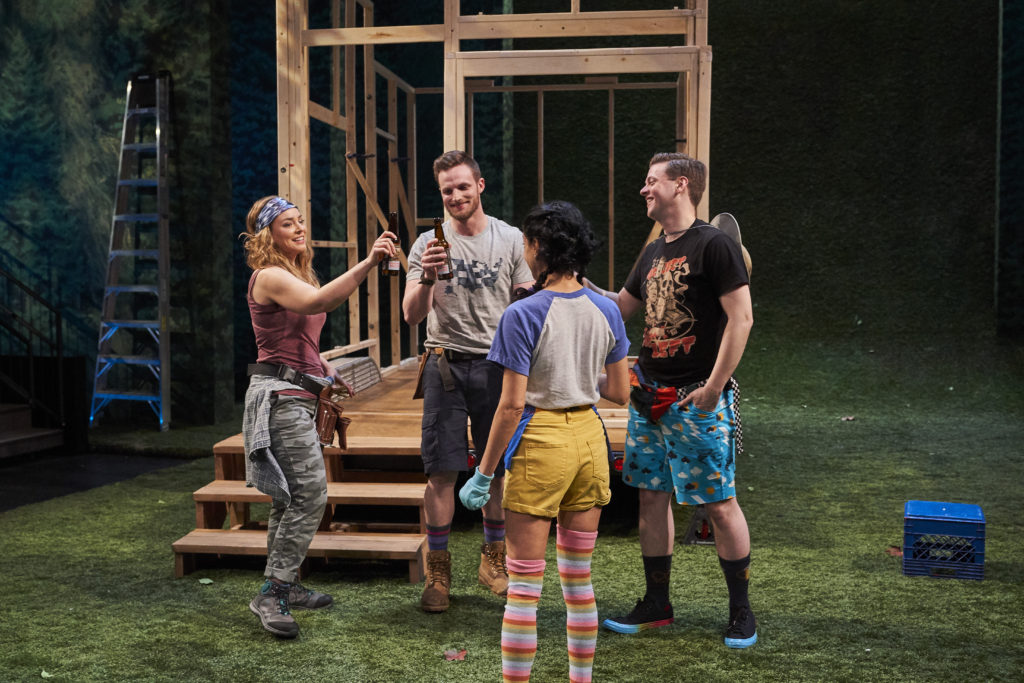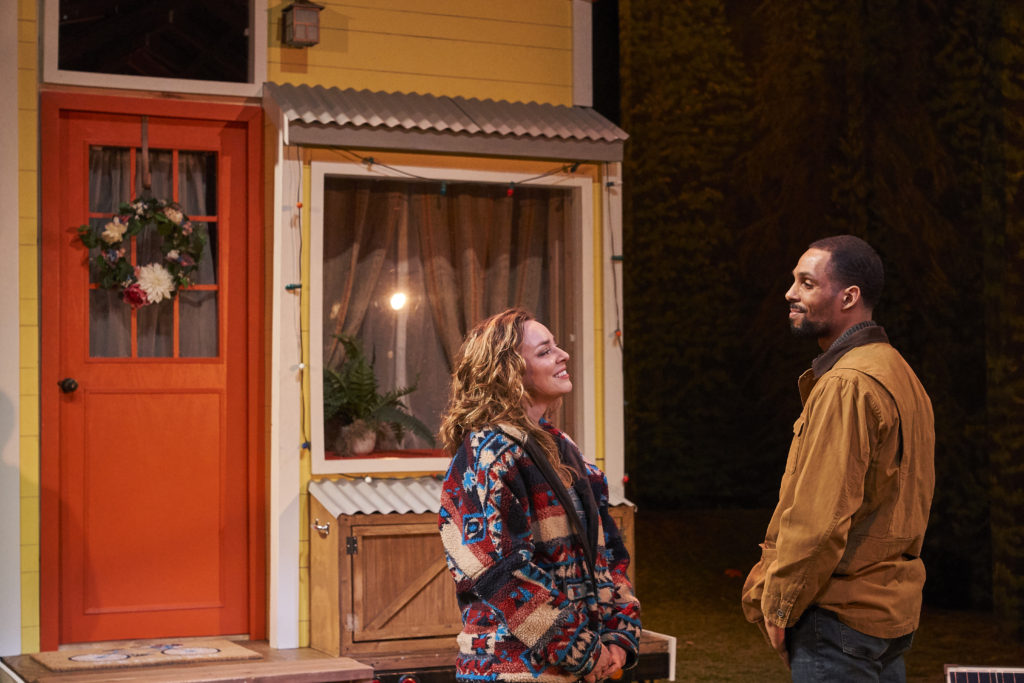
Chelsea Marcantel’s world premiere play hones in on the social phenomenon of tiny houses — but it goes beyond that.
by Rick Pender | May 10, 2019
There’s a kind of time warp going on with the Cincinnati Playhouse’s world premiere production of Chelsea Marcantel’s Tiny Houses. At the outset, Bohdi (Peter Hargrave), the optimistic half of a couple who recently relocated from New York City to northern Oregon, is enthusiastically convinced that he can complete the construction of a 200-square-foot house in three months, maybe four. His girlfriend of four months, Cath (Kate Eastman), a banker who has abandoned employment but is financing the project, is more pragmatic and dubious. They’re conversing on a trailer bed, the foundation for Bohdi’s dream project.
Oregon’s rainy weather impedes progress, but not as much as Bohdi’s preparation (watching YouTube videos) and his questionable work ethic (shooting beers throughout the day). The timetable stretches out by weeks and months. We’re reminded of this by projections on the wall of the Shelterhouse Theater, festooned with woodsy pine greenery. At the same time, Tiny Houses lets us watch the home be constructed in 90 minutes (there’s no intermission).
Help of questionable value comes from two of Bohdi’s past acquaintances. Ollie (Michael Doherty) is hosting the project in his backyard since Bohdi has not yet purchased the necessary land; the plan is to trailer the house into the woods when (or if) it’s completed. Jevne (Nandita Shenoy), a loony girlfriend from Bohdi’s Oregon past, turns up to help, full of second guesses about construction and clearly wangling for Bohdi’s affections.
Ollie and Jevne are each employed, but in a very loose sense. He has an online business that buys and sells “haunted dolls.” (Bizarre as it sounds, this is not an invention for the show: It’s a real thing. You can look it up online.) And Jevne has a self-help blog that assists people in falling asleep with soothing stories and sounds (including “ear brushing” and feather tickling). Bohdi’s career as a stop-smoking counselor is only slightly more believable. Cath, whose resources are being rapidly drained, seeks work, but her career in finance doesn’t get much traction in funky-granola Oregon: She’s on a path to becoming a barista or perhaps a bookstore clerk.
The only person with some focus and direction is Jeremiah (James Holloway), a practical construction guy who Cath hires to bring some discipline to the project. Shifting affections between the characters is part of the show’s humor, which shines an amusing light on millennial attitudes and behaviors. For instance, Ollie speaks with a bizarre accent, but everyone avoids asking him where he’s from since that would be too invasive. With the exception of Jeremiah, they’re all a little nutty, and even he proves to have qualities that veer beyond the expected.

Marcantel’s title is plural: Tiny Houses, rather than, let’s say “The Tiny House.” That’s to reflect the social phenomenon of tiny living, but there’s more to it. Each character lives in their own “tiny house,” relatively oblivious of the desires, needs and concerns of others. Cath yearns for parenthood; Bohdi is obsessed with building but not necessarily maintaining; Jevne clings to her past with Bohdi; and Ollie obsesses over his weird dolls and his even weirder clients. That’s clearly meant to be commentary on this generation, and it’s handled with clever, often hilarious, humor. Eventually, things rearrange and resolve, if not entirely logically.
What’s more, the tiny house actually gets built, thanks to an inventive design by Arnulfo Maldonado and the assistance of stagehands who step in to work with the actors between scenes to assemble the cozy structure complete with curtained windows, a porch light, yellow siding and a skylight.
Director Laura Kepley, the artistic director at the Cleveland Play House — the show is a co-production with that Northeast Ohio theater — has highlighted the humor in Marcantel’s script by using spotlighted monologues for each actor to show off his or her comic chops. This gives us deeper insights into their characters’ offbeat personal psyches. They’re self-absorbed in ways you might recognize, and that’s the fun of this show, even if the message is kind of muddy. The confines of a tiny house pressurize the play’s entertainment quotient, even if these characters are more caricatures. Tiny Houses is like watching exotic animals in a crazy zoo.
Tiny Houses, presented by the Cincinnati Playhouse in the Park, continues through June 2. More info/tickets: cincyplay.com.






